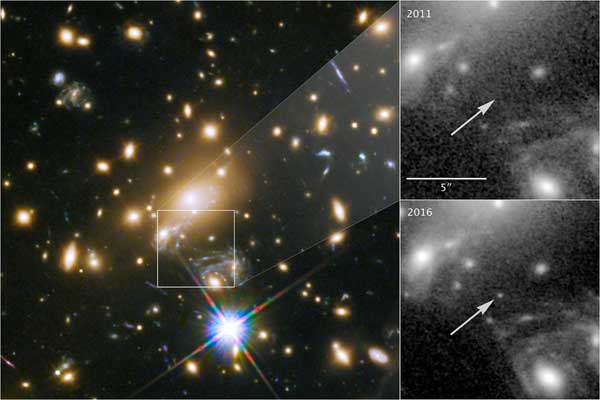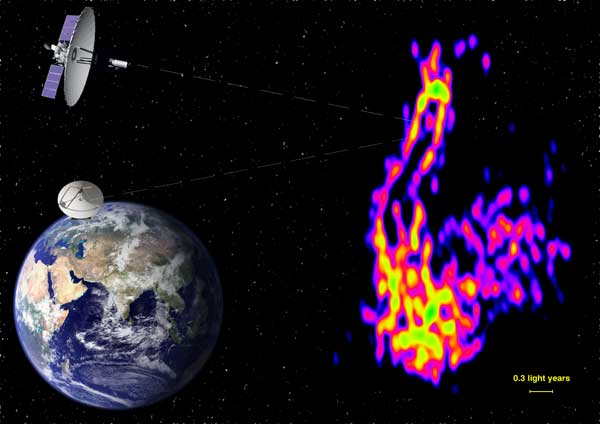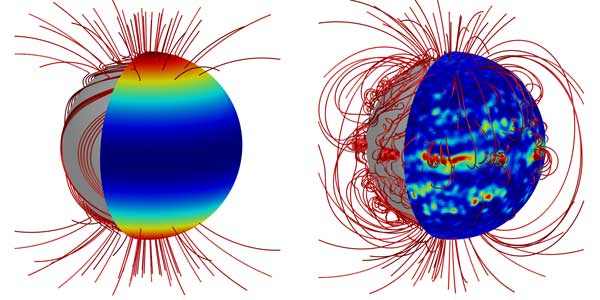Astronomy news this week: Hubble images the most distant star, radio telescopes combine forces to probe black hole jet, and neutron star hotspots explained.
Hubble Images Most Distant Star
It’s difficult to resolve stars in galaxies outside our own, but with the help of some cosmic lensing, the Hubble Space Telescope has imaged a star that existed when the universe was less than a third of its current age (at a redshift of 1.49).
Hubble’s optics were aided by two of the universe’s own lenses. The first was the presence of a foreground galaxy known as MACS J1149-2223, whose immense gravity bent and magnified the light from the background star. The second was something nearer the star with three times the Sun’s mass — perhaps another star, a neutron star, or a stellar-mass black hole — that gravitationally tweaked the starlight in what’s known as a microlensing event. The combination of the two gravitational lensing events magnified the star’s light 2,000 times, making it visible to Hubble.
The star itself is is a blue supergiant, much bigger, brighter, and hotter than the Sun. The results appear in the April 2nd Nature Astronomy, and you can read more about the discovery in Hubble’s press release.

NASA & ESA / P. Kelly (Univ. of California, Berkeley)
Earth-Space Radio Telescope Studies Black Hole Jet
A radio telescope in space, RadioAstron, joined forces with more than a dozen ground-based radio arrays to attain the resolving power of a single radio dish 350,000 km wide. (For reference, Earth and the Moon are on average 380,000 km apart). Its target: a supermassive black hole in the core of 3C 84, the central galaxy in the Perseus cluster, which lies 230 million light-years from Earth. The black hole just restarted a speedy jet of plasma a little more than a decade ago, and astronomers want to see how the jet formed.
Gabriele Giovanni (INAF-IRA, Italy) and colleagues report details of the jet’s structure in the April 2nd Nature Astronomy, concluding that the jet appears to be quite broad (80 light-days across) even relatively close to the black hole.
Astronomers hotly debate whether jets are launched from the energy of inflowing matter or from the spin of the black hole itself. But a black hole’s spin affects only a narrow region around the black hole, known as the ergosphere, and would result in a narrow jet. Instead, the wide plasma jet the astronomers observed points to inflowing matter as its energy source. However, the current observations can’t exclude the possibility that the jet started narrow even closer to the black hole, then quickly broadened. The debate over black hole jet origins continues.
Read more from the Max Planck Institute for Radio Astronomy’s press release.

© Pier Raffaele Platania INAF / IRA (compilation); ASC / Lebedev Institute (RadioAstron Image)
How Hot Spots Survive on Neutron Stars
Neutron stars, the collapsed remnants of burnt-out stars, can exhibit powerful hotspots of magnetic activity. To understand how these fields evolve over time, Konstantinos Gourgouliatos (Durham University, UK) and Rainer Hollerbach (University of Leeds, UK) used the ARC supercomputer at the University of Leeds to “watch” neutron stars with different magnetic field setups evolve over the millenia. Turns out that under certain conditions, neutron stars may form a long-lasting hotspot several kilometers wide, with a magnetic field strength of more than 10 billion Tesla.
The successful “neutron star in a box” starts out with a dipole field — one like Earth’s, with a north pole and a south pole — that — unlike Earth’s — has become tightly twisted, so that most of the magnetic fields are wrapped around the neutron star rather than extending from the north pole to the south pole. The highly wound magnetic field is unstable and breaks into knots that rise to the neutron star’s surface, similar to how magnetically dense sunspots form on the surface of the Sun. Electric currents within the hotspot generate heat that astronomers see as X-ray emission. Even if the overall magnetic field decays, the simulation shows the hotspot surviving for millions of years.

Gourgouliatos presented the results at the European Week of Astronomy and Space Science (EWASS). Read more from the EWASS press release.
 3
3









Comments
Anthony Barreiro
April 10, 2018 at 6:09 pm
I keep thinking about a star like Rigel in that inconceivably distant galaxy, and how everything could possibly line up so precisely in four-dimensional spacetime -- the star, the microlensing object, the lensing galaxy cluster, the space telescope, the astronomers, Nature Astronomy, Sky and Telescope, and me! It blows my mind!
You must be logged in to post a comment.
fif52
December 4, 2018 at 7:15 am
MACS J1149+1122 could be a phantom star. what's your opinion? Could gravitational waves cause this?
You must be logged in to post a comment.
fif52
December 4, 2018 at 7:16 am
I mean MACS J1149 lenses star.
You must be logged in to post a comment.
You must be logged in to post a comment.